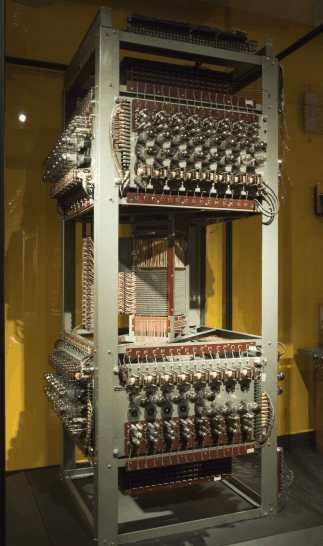| IEEE Milestones for Whirlwind and SAGE |
| Written by Historian | |||
| Monday, 02 July 2012 | |||
|
Whirlwind, the world’s first real-time digital computer, and SAGE first electronic air-defense system and a forerunner of today’s air-traffic-control systems and computer networks, both of which were developed at MIT, have been recognised as IEEE Milestones The IEEE Milestones in Electrical Engineering and Computing program honors significant technical achievements that occurred at least 25 years ago with bronze plaques placed at an appropriate site with an accompanying dedication ceremony. One such event took place in Boston on June 27, 2012 when MIT's Project Whirlwind and its follow-on project, the United States Air Forceʼs Semi Automatic Ground Environment (SAGE) system.
 From left to right Robert Everett, Jay Forrester and IEEE president Gordon Day (Source: MIT News) From left to right Robert Everett, Jay Forrester and IEEE president Gordon Day (Source: MIT News)
As both Whirlwind and SAGE were defense projects, they were highly classified at the time. MIT's account of the event also provides an interesting historical overview. The Whirlwind project began with the U.S. Navy approaching MIT in search of computer systems for future military applications. Jay Forrester, who was in charge of the Whirlwind project and is now an MIT professor emeritus of management, recalled: This was at a time when no general-purpose, reliable, high-speed computer had yet functioned. Indeed, it wasn’t clear that the demanding specs the Navy wanted to meet were even possible: In one of the initial meetings over the concept, the MIT researchers met with Navy officials who thought the project might cost $100,000; instead, the project wound up costing many millions. Whirlwind was the first computer ever to use magnetic-core memory, a system that went on to dominate the computer industry for two decades. It was also the first to use a CRT display to show its output, and the first that was fast enough to provide real-time computations, allowing it to be used to control an aircraft simulator for bomber pilots. On the other hand, it had less computing power than today’s pocket calculators. Its total core memory (now known as RAM) amounted to 2,024 16-bit words, or 4,048 bytes (4 Kb). The computer’s memory, control systems and input and output devices were arrayed in towering racks that took up most of a 2,500-square-foot building. A section of the Whirlwind computer (Source: MIT News)
As the Cold War began, the U.S. Air Force became interested in harnessing Whirlwind’s impressive power to develop a real-time monitoring system for radar (which MIT had helped to develop during World War II) to detect possible bomber attacks. This led to the development of SAGE, the system for which MIT created its Lincoln Laboratory, which was not only the first electronic air-defense system, but also a forerunner of today’s air-traffic-control systems and computer networks. The original plan had been for the Lincoln Lab to shut down after SAGE was developed. Instead it is still in operation and so is MITRE Corp. Both Jay Forrester and Robert Everett, who worked on the Whirlwind project, headed the SAGE project, and then became president of MITRE Corp were present at the IEEE Milestone event. Everett praised Forrester’s leadership: “I worked for Jay for many years. He was responsible for Whirlwind, and therefore for the construction of SAGE, and the creation of Lincoln Lab, and MITRE Corp. If it were not for him, the whole computer industry would be quite different.” There is a great deal more to say about both these Cold War projects and our two history articles on the topics Jay Forrester and Whirlwind and SAGE - Computer of the Cold War include some fascinating insights into the development of computer technologies in the 1940s and 1950s. More InformationMilestones:Semi-Automatic Ground Environment (SAGE) 1951-1958 IEEE honors MIT milestones (MIT News) Related ArticlesSAGE - Computer of the Cold War
Comments
or email your comment to: comments@i-programmer.info
To be informed about new articles on I Programmer, install the I Programmer Toolbar, subscribe to the RSS feed, follow us on, Twitter, Facebook, Google+ or Linkedin, or sign up for our weekly newsletter.
|
|||
| Last Updated ( Friday, 18 November 2016 ) |


